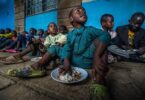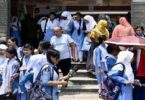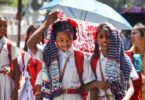KABUL (Agencies): Afghanistan is facing a worsening humanitarian crisis, and it’s hitting children especially hard. When the Taliban took control back in August, most Western funding was cut off and the country’s assets were frozen. Without this money, the economy has collapsed, most health facilities have closed and people are unable to buy food, exacerbating a drought and famine that already existed.
Nearly 23 million Afghans face acute hunger, according to the World Food Programme. An analysis by the humanitarian group Save the Children found that 14 million of those people are kids, and 5 million are close to reaching famine-like conditions. Around 13,700 newborn babies have died due to lack of nutrition since January,according to data shared by the Ministry of Public Health last month. Hunger isn’t the only problem. School attendance has plummeted, and last week, the Taliban reneged on a commitment to reopen schools for girls above sixth grade.
Humanitarian agencies are now Afghanistan’s only lifeline. The United Nations called on countries to provide humanitarian aid of $4.4 billion for Afghanistan, but the nation is still waiting on those much-needed funds. Save the Children has been working in Afghanistan since 1976 and has a presence in 10 of the country’s provinces. After a brief hiatus following the Taliban takeover, it resumed operations in October.
Janti Soeripto, president and CEO of Save the Children, visited Afghanistan in early March. Soeripto spoke with HuffPost about the current situation in Afghanistan and how the children there are faring. I would say by far Afghanistan is the worst humanitarian crisis on the planet currently. And it is not a great statement, knowing that Yemen is the second-worst crisis on the planet, and Yemen did not get any better either over the last six months. It’s just that Afghanistan got a lot worse.
When I spoke with people in the country, they were surprised by how rapidly the concrete situation deteriorated in terms of malnutrition rates, economic hardship, education and child protection issues. It was not perfect before the 15th of August, let’s be very clear. But it rapidly deteriorated. Daily visits of children [to Save the Children clinics] who present malnutrition symptoms have more than doubled over the past five months. We were seeing up close, immediately, that children [were dying] of hunger in very remote areas where there wasn’t a lot to begin with, but also in urban areas, where before there was definitely a more stable situation.
The main concern for kids [in remote areas] is dengue, measles and diarrhea. In a lot of those areas, mobile health clinics are the only basic health care that is available. Before the 15th of August, we had a little over 2,000 health care facilities. About half of those are still not back up and running. The minister of education told me that they think up to 8 million kids are currently out of school, and before the 5th of August, we had roughly 2.5 million kids out of school. A fourfold increase over the last six months of children not being able to access schools is deeply disturbing.
Not allowing girls back into school was a huge disappointment and a real surprise. On Saturday, our team met up with the ministry of education when they were still excited about all kids going back to school. And then [of last week], the opposite happened. That was a real step back. I had a chance to visit a couple of [primary] schools that we run in greater Kabul for girls. The girls were amazing. They were super engaged and energetic that they were learning. You know, they told me that they wanted to become doctors and nurses and teachers. But they also told me that they were concerned, and their mothers told me that they were concerned that they would not be able to continue their education after primary school.
We would love to continue to do educational programs when we know how to do them. But we need to make sure we do not put girls at more risk. We need to continue with the education programs that we have. We would like to scale them up [and train] almost 1,000 female teachers. Because even if we had a policy that allowed girls to go back to high school, you must have female teachers to teach them. We want to make sure that even the practical barriers do not get in the way of girls going back to school aside from the whole policy conversation. We need to push forward with some of those practical opportunities we are looking at, such as doing informal education for girls of secondary — higher ages.
But we are going to look at that cautiously. We are not going to jump in without thinking that through and doing appropriate risk assessments to make sure that we can do it as safely as possible. There is an immediate issue for humanitarian agencies to get access to cash to continue our work. We have a little bit of access through a single international banking partner that still does business with Afghanistan. We have the UN, which has been incredibly creative in making sure that it gets cash into the country for their own operations as well as for some of the international players on the ground. And then we are using informal money changers — which, of course, is expensive and risky, and it is not very sustainable. But our bigger concern is an economy that is completely dysfunctional because of those sanctions, and humanitarian funding alone will never replace a functioning state economy.
We have worked with the Taliban before. They were in control in a number of areas before the takeover. So we’ve had to have these conversations at an operational level before, and we had to have them where we wanted to progress. We felt that the negotiations we managed to have in the various provinces led to enough acceptable outcomes for us to be able to start our work. We can do our work with female staff, which was, for us, an absolute must-have. We have been able to get visas for international colleagues. Now, it is also quite clear that when we speak to the authorities, they are not always speaking with one voice. What you hear in one ministry can then be completely turned around the next day by somebody else, so things that you agree on at a national level do not always happen at a provincial level and the other way around. So that is the balance that all of us who are operational in the country are trying to find.
We have various scenarios for this one. There was always hope, because otherwise you can’t be in this line of work. The hope was and still is that, you know, this educational setback is a temporary one, that we can get to the right level of agreement with the authorities to allow girls to get back into school.
[The other hope is] that the international community can really get behind the people of Afghanistan and provide humanitarian funding. Let’s not forget that the humanitarian funding that is being asked for, over $4 billion, is a fraction of the money that was spent every year during the war.
Could it get worse? Yes, it could — if the harvest fails, if seeds are not put into the ground, if we can’t get the amount of food into the country that we were counting on because of the Ukrainian crisis and general inflation. It could still get a lot worse, and that ultimately could also lead to more violence. So we definitely have a worst-case scenario. We also have a better-case scenario. And for that, we do need a lot of political will, but also international engagement with the country.






